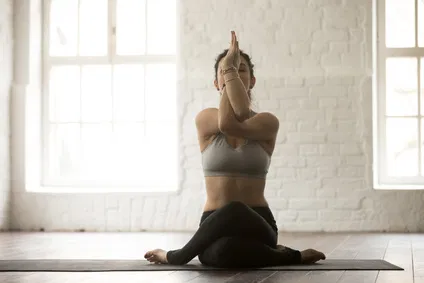It's not just you with an office job that is burdened by tension on a daily basis. Hardly anyone has not experienced shoulder and neck tension - long sitting, bad posture or simply stress are common factors that burden us. Even a few simple yoga exercises against shoulder and neck tension can help you to get rid of tension!
Why yoga is ideal for relieving tension
Especially tension in the shoulder and neck area can not only be terribly uncomfortable, but also lead to chronically tense muscles. Typical consequences are also headaches, a low breathing volume, as well as poor posture, which in turn results in back pain. To break this chain, it is necessary to open the shoulders.
But what exactly is meant by this? All yoga exercises against shoulder and neck tension, which integrate the areas of shoulders and neck, aim to pull the spherical condyle of the humerus into the socket of the shoulder blade. To do this, the shoulder girdle must first be stabilized. Also consider the importance of activating your shoulder blades. Pulling the tips of your shoulder blades together opens the front of your body.
Exercises for the shoulders and neck are therefore also particularly important to relieve the chest area and the upper back. This means that they also prevent a rounded upper back, which you probably know as a "relieved posture". With the following yoga exercises you can loosen and relax the tense chest muscles - thereby you will succeed in an upright posture and the shoulder and neck tension will disappear from your life:
4 yoga exercises for shoulder and neck tension: this is how you relax
Try these yoga exercises:
Exercise 1: Eagle Arms

Eagle arms are an effective exercise to relax the neck area.
- Assume an upright, straight sitting posture.
- The arms and fingers are actively bent, the right arm you now swing over the left, so that the elbows come over each other.
- Try to bring your palms closer together.
- Stay upright and gently pull the elbows down.
- For a few breaths you stay in this position.
Now you can practice the other side.
Important: Breathe into the back of your shoulders. With each inhale you create width, with each exhale you can consciously relax. If you want to additionally stretch your shoulders and back, pull your elbows towards your belly button.
Exercise 2: Exercise with crossed thumbs
- Push the arms upwards.
- In this exercise, however, you cross your thumbs - the other fingers are spread wide.
- Now bend the arms generously and pull strongly on the thumbs, but do not release them. This moves the elbows wide apart.
- Bend the arms until the thumbs come toward the back of the head.
- Concentrate on your breathing.
- As you exhale slowly, stretch your arms. Make the movement from the shoulders. Continue to pull forcefully on the thumbs.
- You use the resistor to go from the back to the length.
- Do the exercise several times in a row.
You can also do this in between times in the office. You don't need any equipment or other prerequisites, except a little concentration.
Exercise 3: Integrate shoulders
- Again, assume a comfortable, upright sitting posture.
- You push your arms forward, fingers are interlaced, palms are pushed forward.
- Now pull the shoulders back. This pushes or integrates the head of the humerus into the socket.
- Keep your shoulders down at the back and push your arms up towards the ceiling.
- Your arms are bent just a little, you pull your shoulders away from your ears.
If you want, you can also take a yoga block! Simply clamp the block between the heels of your hands. This intensifies the connection to the back of the body and the shoulder blades. Inhale, pull your arms up, exhale, return to the center.
Exercise 4: The dolphins
- Start in the quadruped position.

- Bring the forearms to the floor. The elbows should be exactly under the shoulder joints and remain there.
- Interlace your fingers - this will create a firm base over your forearms.
- Now stretch your legs and push your buttocks upwards. Your back remains long, the legs are actively stretched.
- Inhale, push your head in front of your fist. Your upper body comes parallel to the floor, legs remain stretched.
- Exhale and push your buttocks back up.
- You can repeat this exercise 5-10 times, depending on your condition.
For even more dynamics you can stretch one leg upwards and do the dolphins on only one leg. Note: if the upper body goes forward, then the raised leg is also parallel to the floor. Repeat on the other side and then relax.





